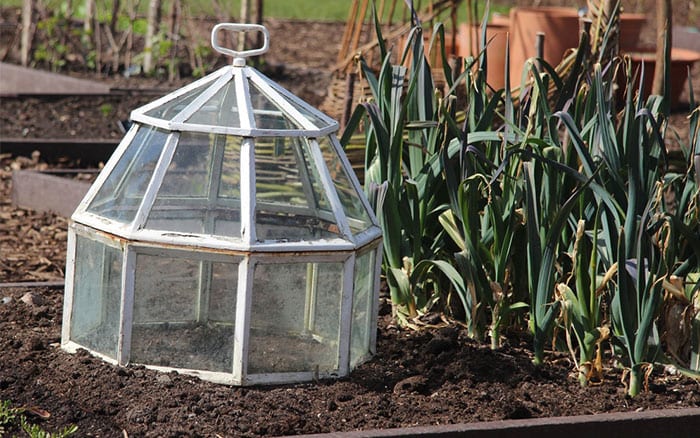You can extend the life of your winter plants, especially herbs and vegetables, by covering them with protection. Cloches, cold frames and polytunnels are like mini unheated greenhouses that keep out the cold and wind and help retain heat around the plant.

British weather is unpredictable by nature. One day it’s cold, overcast and damp, the next it’s raging gales – then the day after is all blue skies and sunshine.
But for plants, that unpredictability can wreak havoc, especially in autumn and early winter. Winds and sudden cold snaps can damage plants, so protection is vital.
They can also be used to protect half-hardy and vulnerable plants from frost.
Here’s how to keep your garden protected and productive over winter.
Cloches
Cloches are glass or plastic domes or square structures that fit over individual plants. The word cloche comes from French and means ‘bell’, a reference to their shape. Cloches were originally made from glass but modern versions are plastic, which is much less likely to break.
They are used as portable greenhouses, taking the protection out to plants in the soil. Their greenhouse effect can also be used to ripen the last fruits from tomatoes, peppers and chillies without the cost of a greenhouse.

The problem with early glass cloches is ventilation. On sunny days, the heat can cause condensation in the cloche and damage the plant. Gardeners had to prop the cloche up with a small rock to allow air to circulate.
Modern cloches come with ventilation like a panel or window that opens. Square lantern-shaped cloches have detachable pyramid lids that can be rotated slightly, creating air holes.
They are a great cost-effective way to protect half-hardy plants without installing a large structure like a greenhouse. And they come in handy during spring and summer when you want to protect young plants from pests like slugs.
Cloches can also come in opaque terracotta, which is used in the spring to force rhubarb. It creates a dark, warm environment to encourage new shoots to grow.
Cold frames

Cold frames are like miniature greenhouses. They are usually attached to the side of a house and have brick walls and a glass roof that can be lifted for ventilation.
You can build a small DIY cold frame by making a low brick wall and attaching an old window pane to the top. The lid needs to slope downwards to allow water to drain away.
Cold frames are cheaper and smaller than a greenhouse and will protect tender plants from frost. They are often used to sow seeds earlier in the year and to harden off indoor-sown seedlings before transplanting into the garden. And they keep out pests.
A cold frame is ideal for harbouring tender plants like fuchsias and geraniums over winter. Pack the inside walls with straw to stave off the worst of the cold.
Polytunnels
Polytunnels are pop-up plant protection tunnels, usually made from plastic hoops that suspend a layer of horticultural fleece over the plants. The ends can be tied and pinned to the ground during cold weather and lifted and opened to allow ventilation on warm days.
Polytunnels are great for long rows of vegetables like salads, and can be used to keep plants cropping for much longer.

They are also great during the summer as a low-cost greenhouse. Tomatoes and peppers will ripen much faster in that warmer environment.
The downside to polytunnels is that they are hardly attractive features for a decorative garden, and mostly used by serious veg growers. But if you do grow your own food, consider putting a polytunnel in your garden to get even more produce.

Leave A Comment